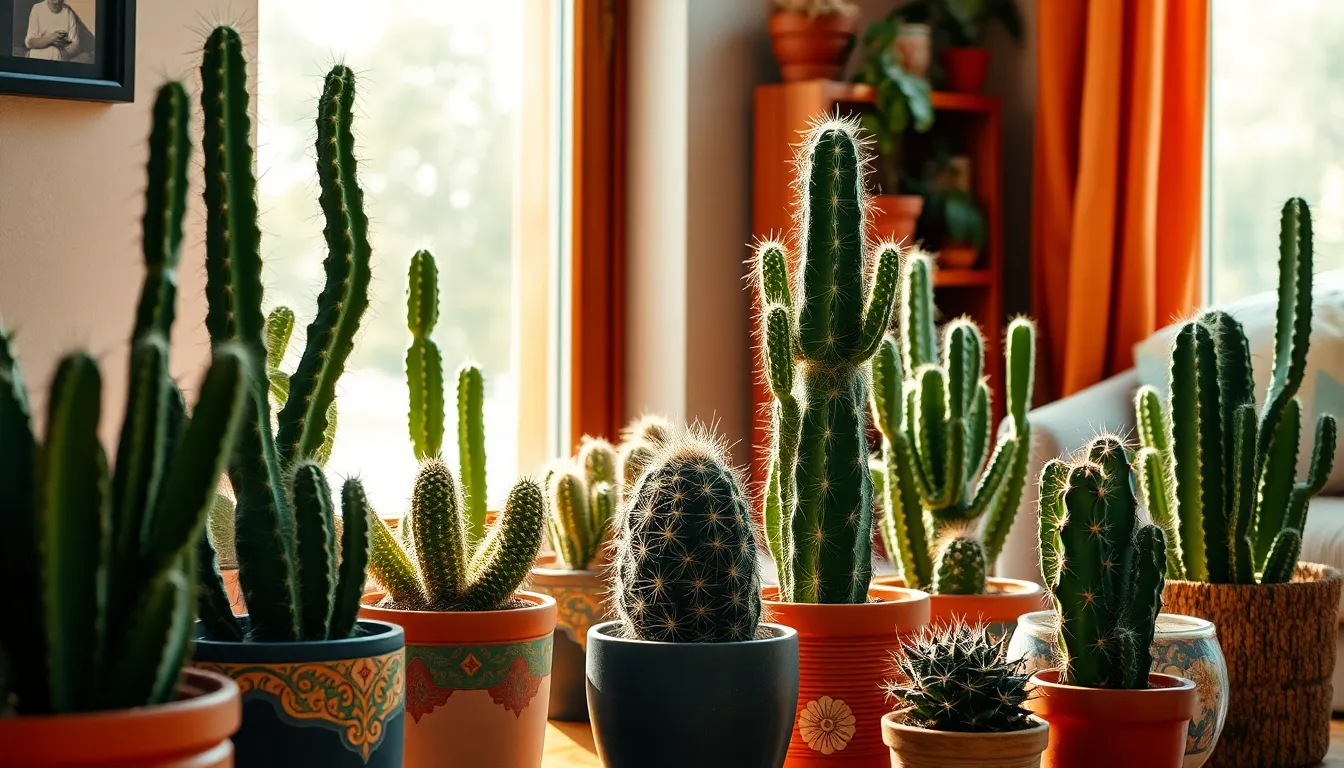Table of Contents
ToggleCactus house plants are the ultimate low-maintenance companions for anyone who’s ever struggled to keep a fern alive. With their quirky shapes and vibrant blooms, these spiky wonders add a touch of desert charm to any home. Plus, they won’t judge you for forgetting to water them—after all, they thrive on neglect!
Overview of Cactus House Plants
Cactus house plants serve as exceptional low-maintenance companions. Their ability to thrive in arid conditions sets them apart from other houseplants. Unique shapes and vibrant flowers enhance home decor, offering a touch of the desert indoors. Notably, cacti require minimal watering, making them suitable for busy individuals or those who often forget to water plants.
Diverse varieties of cacti exist, including the popular Christmas cactus, which produces stunning blooms. Different species exhibit distinctive features, such as spines and colors, appealing to various tastes. Owners appreciate the adaptability of cacti, as they can flourish in a wide range of light conditions, from bright sunlight to partial shade.
Maintenance involves simple tasks like infrequent watering and occasional dusting. Most cactus varieties thrive in well-draining soil, preventing root rot and promoting healthy growth. Implementing proper drainage is crucial for ensuring long-term health.
Cacti offer benefits beyond aesthetic appeal. They improve indoor air quality by absorbing carbon dioxide and releasing oxygen. Selecting the right cactus can enhance well-being and contribute to a calming environment.
For those new to houseplants, starting with cacti provides a rewarding experience. The forgiving nature of these plants encourages ownership without the stress often associated with plant care. With proper placement, cacti can flourish in any home, providing both beauty and resilience.
Benefits of Cactus House Plants

Cactus house plants offer numerous advantages, especially for individuals who prioritize low maintenance and air purification. Their unique characteristics contribute to a thriving indoor environment.
Low Maintenance Requirements
Most cactus varieties require minimal care. They flourish with infrequent watering, often needing it only every few weeks. Busy individuals or those prone to forgetfulness find cacti particularly appealing. These plants thrive in poor soil conditions, as long as it drains well. Sunlight requirements are flexible, allowing cacti to adapt to different light levels. A sunny windowsill often provides an ideal environment, making it easy to incorporate into homes. Overall, their resilience means cacti seldom need pruning or specialized care.
Air Purification Properties
Cacti positively impact indoor air quality. By absorbing carbon dioxide during the day, they release oxygen at night, unlike many other house plants. Some studies indicate that specific cacti can help filter harmful pollutants, creating a healthier indoor atmosphere. Homes with cacti may experience improved air quality, benefiting both physical health and mental well-being. Their ability to thrive in compact spaces makes them perfect for small apartments, where every bit of clean air counts. Incorporating cacti creates a fresh environment, promoting a sense of well-being indoors.
Popular Cactus Varieties for Indoors
Cacti offer various appealing options for indoor gardening enthusiasts. Popular varieties include the charming Christmas cactus and the intriguing Madagascar palm.
The Classic Christmas Cactus
The Christmas cactus, scientifically known as Schlumbergera, stands out for its beautiful, tubular flowers that bloom during the holiday season. Owners appreciate its vibrant shades, ranging from pink to white. This cactus thrives in bright, indirect light but can tolerate lower light levels, making it versatile for home environments. Watering every two to three weeks gives it the sustenance it needs without the risk of overwatering, which can lead to root rot. It’s essential to place the plant in well-draining soil, allowing it to flourish throughout the year.
The Unique Madagascar Palm
The Madagascar palm, or Pachypodium lamerei, offers a striking presence with its thick trunk and distinctive spiky leaves. This succulent grows slow but rewards patience with its unusual appearance. It thrives in bright, direct sunlight, requiring placement near a sunny window. Watering should occur every two weeks, allowing the soil to dry between waterings. Proper drainage is vital; this keeps the roots healthy and prevents over-saturation. Its unique profile adds character to any indoor space, making it a conversation starter.
Care Tips for Cactus House Plants
Cactus house plants thrive with minimal attention, making their care straightforward and manageable.
Watering Guidelines
Watering cacti requires a unique approach. Cacti generally prefer dry conditions, so the soil should dry out completely between waterings. Most cacti need watering every two to three weeks, especially during the growing season in spring and summer. During fall and winter, reduce watering frequency even further to once a month or less. Providing well-draining soil helps prevent root rot, a common issue when cacti sit in excess moisture. Check the soil moisture by inserting a finger about an inch deep; if it’s dry, it’s time to water.
Light Requirements
Cacti adapt well to various lighting conditions. Most species thrive in bright, direct sunlight for several hours each day. Ideal placement includes south- or west-facing windows. Some varieties, like the Christmas cactus, prefer bright, indirect light, which promotes healthy growth and blooming. Insufficient light may lead to weak, leggy plants that stretch towards the light source. Observe your cacti regularly; if they begin to show signs of sunburn, such as discoloration, consider relocating them to a spot with filtered light. Adjusting light conditions ensures optimal health and vibrant growth.
Common Pests and Problems
Cacti can face several pests and problems that may affect their health. Identifying these issues early helps maintain their vibrant appearance.
Identifying Pests
Mealybugs often appear as white, fluffy spots on cactus surfaces. Scale insects can produce small, hard bumps and may cause discoloration. Spider mites introduce webbing and tiny dots on the leaves, indicating a decline in health. Aphids cluster on new growth and can stunt development. Regularly examining plants for signs of these pests promotes early intervention. Utilize a magnifying glass for thorough inspections to catch hidden infestations.
Treatment Options
Manual removal works effectively for pests like mealybugs and scale insects. Gently wiping affected areas with a cotton swab dipped in rubbing alcohol eliminates these pests. Insecticidal soap provides a convenient solution, offering broad-spectrum control. Neem oil, a natural insecticide, disrupts the life cycle of pests when applied regularly. Introducing beneficial insects, like ladybugs, can establish a natural balance in the environment. Monitoring cacti consistently aids in the effective management of these issues.
Cactus house plants offer an excellent option for anyone seeking low-maintenance greenery that enhances their living space. Their unique aesthetics and vibrant blooms can transform any room while requiring minimal care. With their ability to thrive in various light conditions and forgiving watering needs, cacti are perfect for busy lifestyles.
These resilient plants not only beautify homes but also contribute to improved air quality. For those new to indoor gardening or experienced plant enthusiasts, cacti provide a rewarding experience. By choosing the right variety and following simple care guidelines, anyone can enjoy the charm and benefits of these remarkable plants. Embracing cacti in home decor is a step toward creating a fresh and inviting environment.




